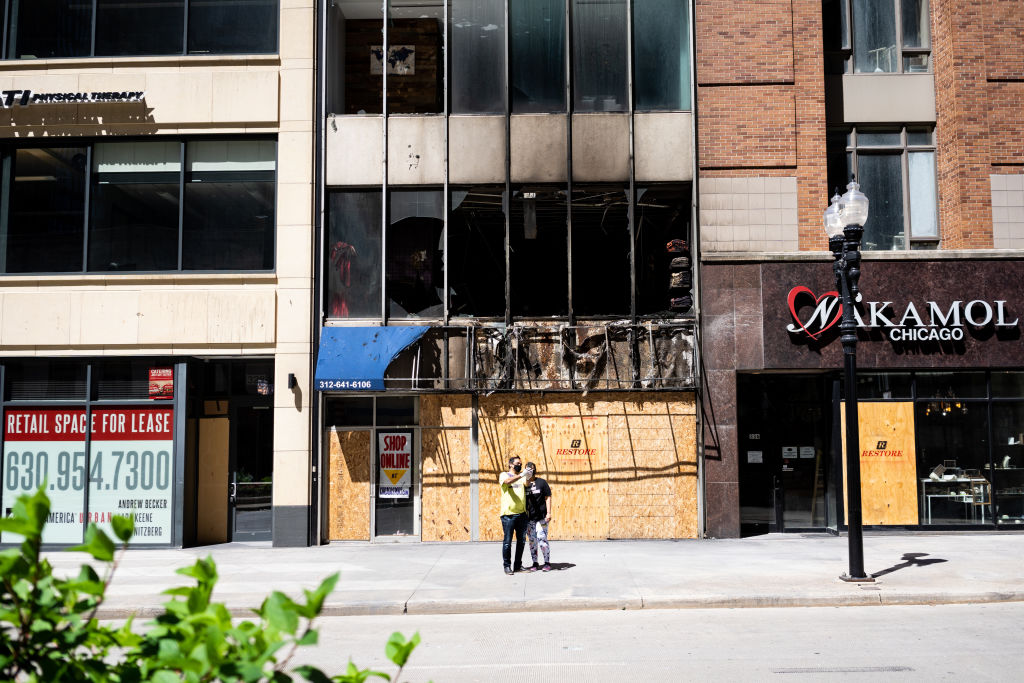A week ago Monday, during the second spate of looting downtown this summer, Louise Cohn stood at the window of her Michigan Avenue condo watching the scene below. She heard glass breaking and gunshots, saw people rushing through store windows hauling expensive merchandise. (According to a security guard on Oak Street, there was only “one shoe” left at Jimmy Choo the following morning.) Cohn stayed up until 5:45 a.m., unable to stop looking at the street jam-packed with cars. When she awoke, there was an armed guard in the lobby of her building.
Cohn has lived along the Mag Mile for three years, but now she’s thinking about leaving. "At my [building], there’s a number of properties for sale. The Monday after the Sunday [looting], a number dropped their prices.”
Even though it’s right in the middle of the city, the Streeterville/Mag Mile neighborhood is a place apart from the rest of Chicago. It’s older, wealthier, whiter, and doesn't attract as many families. The median household income in the 60611 zip code — $85,600 — is nearly twice as high as Chicago’s. The residents, who are more likely to work in finance, law, or management, are able to spend most of that money on themselves. Only 4.6 percent of households contain families, compared to 41.2 percent for all of Chicago. More than half of households contain just one person.
In a city of neighborhoods, it’s questionable whether Streeterville meets the traditional description. It’s a public school desert, with only two neighborhood elementaries — Ogden and South Loop — two miles apart. (A third, the bilingual school Salazar, takes students from across the city.) There are no single family homes, and it’s not a place where people put down roots: 62 percent of Streetervillians were born outside Illinois, according to city-data.com.
Downtown living is a fairly recent development in Chicago, but it was central to the economic strategies of Richard M. Daley and Rahm Emanuel. Those mayors knew that if they wanted to attract corporate headquarters to the Loop, they needed to give high-earning office workers a fun place to live. Due to developments like the Riverwalk, bike sharing, and Block 37, Chicago has one of the fastest-growing residential downtowns in the United States, even as it loses total population, especially Black residents.
Could the unrest on Michigan Avenue reverse downtown’s growth? After all, it's easy for residents of the greater Loop area to move: they have money, and their connections to the region, and even to the city, are often tenuous.
Jill Hammelman, a hairdresser, moved from New York to downtown Chicago ten years ago, attracted by affordable big city living. Since the looting on Michigan Avenue, “I’ve been interviewing out of state for the first time ever,” she said. “I’ve heard there are 40 apartments for rent or sale [in my building]."
For his part, 2nd Ward Ald. Brian Hopkins has called for bringing in the feds to protect downtown. He claims that his ward, in combination with one other, produces about 40 percent of the city’s property tax revenue each year.
“If it happens a third time, people who are just hanging onto a belief that downtown is still a place to live and shop are going to give up,” Hopkins told CBS2. “We’re going to lose people. They’re going to move. We’re already seeing that start to happen.”
Mayor Lori Lightfoot is certainly trying to make them feel safer. Currently, the streetscape of the Magnificent Mile can be summed up in two words: cops on plywood. More than a week after the looting, a police SUV with flashing blue taillights sits on every corner downtown, a trio of officers watching the street. On Monday, five mounted policemen were lined up in front of the Wrigley Building. On the list of boarded-up storefronts is a who's-who of the world’s most expensive brands: Tiffany, Ferragamo, Coach, Rolex, Burberry, Ralph Lauren, Louis Vuitton. The Apple store on the river is empty, with a note on the door reading, “Our retail store is closed until further notice.” (One place that didn’t get hit: the Gap. “We were really surprised,” a clerk said. “I guess they didn’t want jeans.”)
Catherine Sharp is that rarest of birds, a Streeterville native. Although Sharp is only 24, she’s probably lived in the area longer than most of her neighbors. As she sees it, most Streeterville residents live in a downtown bubble of work and play, which is why they were so shocked when the city’s troubles arrived at their doorsteps. Sharp's work as a political field organizer takes her all around the city, where she's become familiar with the refrain that the city lavishes resources on downtown at the expense of the outlying neighborhoods.
“I think the people in [Streeterville] don’t understand how it is in other neighborhoods,” Sharp said. “Most of the people living in Streeterville, they have Loop jobs, and that’s kind of as far as they go. [When] these anomalies happen, people are absolutely terrified. But in terms of developing the city, Streeterville is not where we need to be looking at putting resources.”
That’s because Streeterville and the Magnificent Mile will continue to thrive, even without the city’s help. They bounced back from the 2008 recession, and they will bounce back from the recent “events around public safety,” as Sharp puts it. The proximity to the Loop, the parks, and the beaches are just too convenient.
“I can understand people moving out,” Sharp said, “but I don’t think homes are going to be vacant for long. This is still one of the most desirable places to live in the city.”



